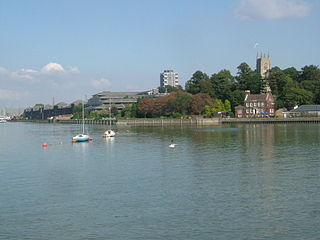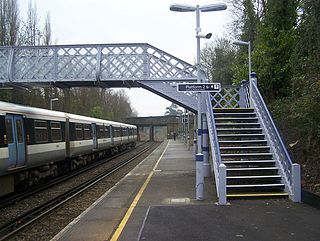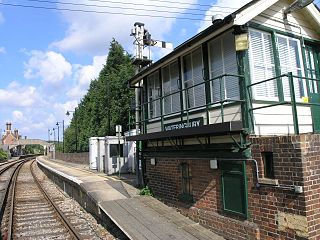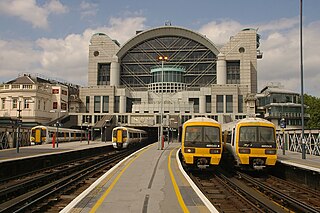
Medway is borough and unitary authority area in Kent, South East England. It had a population of 278,016 in 2019. The unitary authority was formed in 1998, when the boroughs of Rochester-upon-Medway and Gillingham were merged to form Medway Towns. The borough is governed by Medway Council, a unitary authority which is independent of Kent County Council, but remains part of the ceremonial county of Kent.

The River Medway is a river in South East England. It rises in the High Weald, West Sussex and flows through Tonbridge, Maidstone and the Medway conurbation in Kent, before emptying into the Thames Estuary near Sheerness, a total distance of 70 miles (113 km). About 13 miles (21 km) of the river lies in East Sussex, with the remainder being in Kent.

Tonbridge and Malling is a local government district with borough status in Kent, England. The council is based at Kings Hill. The borough also includes the towns of Tonbridge and Snodland along with numerous villages including Aylesford, West Malling and surrounding rural areas.

Strood railway station serves the town of Strood in Medway, England. It is on the North Kent Line and is also a terminus of the Medway Valley Line. It is 31 miles 11 chains (50.1 km) down the line from London Charing Cross.

The Chatham Main Line is a railway line in England that links London Victoria and Dover Priory / Ramsgate, travelling via Medway.

Paddock Wood railway station is on the South Eastern Main Line and Medway Valley Line in south-east England, serving the town of Paddock Wood, Kent. The station also serves the villages of Matfield, Brenchley and Horsmonden, which do not have stations of their own. It is 34 miles 67 chains (56.1 km) down the line from London Charing Cross. The station and all trains calling there are operated by Southeastern.

Cuxton railway station is on the Medway Valley Line in Kent, England, and lies well to the east of the village of Cuxton. It is 33 miles 36 chains (53.8 km) down the line from London Charing Cross via Strood and is situated between Strood and Halling. The station and all trains that serve the station are operated by Southeastern.

Maidstone West railway station is one of three railway stations which serve the town of Maidstone, in Kent, England. It is on the Medway Valley Line, 42 miles 36 chains (68.3 km) from London Charing Cross via Strood and situated between Maidstone Barracks and East Farleigh. The station and all trains that serve the station are operated by Southeastern.

Maidstone Barracks railway station is one of three railway stations which serve the town of Maidstone in Kent, England. Originally opened as Barracks station, it is named after the nearby Invicta Park Barracks and lies on the Medway Valley Line, 42 miles (68 km) from London Charing Cross via Strood between Aylesford and Maidstone West. The station and all trains that serve the station are operated by Southeastern.

Halling railway station is on the Medway Valley Line in Kent, England, and lies a little to the north of the village of Halling. It is 35 miles 18 chains (56.7 km) down the line from London Charing Cross via Strood and is situated between Cuxton and Snodland. The station and all trains that serve the station are operated by Southeastern.

Snodland railway station is on the Medway Valley Line in Kent, England. It serves the town of Snodland, which lies some way to the west. The station is 36 miles 59 chains (59.1 km) down the line from London Charing Cross via Strood and it is situated between Halling and New Hythe. All trains that serve the station, and the station itself, are operated by Southeastern.

New Hythe railway station is on the Medway Valley Line in Kent, England, serving the village of New Hythe. It is 38 miles 3 chains (61.2 km) down the line from London Charing Cross via Strood and is situated between Snodland and Aylesford. The station and all trains that serve the station are operated by Southeastern.

Aylesford railway station is on the Medway Valley Line in Kent, England, serving the village of Aylesford. It is 38 miles 74 chains (62.6 km) down the line from London Charing Cross via Strood and is situated between New Hythe and Maidstone Barracks. The station opened on 18 June 1856.

East Farleigh railway station is on the Medway Valley Line in Kent, England, located to the south-west of Maidstone and close to the village of East Farleigh, on the opposite (south) bank of the River Medway, though the station is actually located in Barming parish. It is 42 miles 75 chains (69.1 km) down the line from London Charing Cross via Paddock Wood. The station and all trains that serve the station are operated by Southeastern.

Wateringbury railway station is on the Medway Valley Line in Kent, England, serving the villages of Wateringbury and Nettlestead. It is 39 miles 77 chains (64.3 km) down the line from London Charing Cross via Paddock Wood and is situated between Yalding and East Farleigh. The station and all trains that call are operated by Southeastern.

Yalding railway station is on the Medway Valley Line in Kent, England, serving the village of Yalding. It is 38 miles 19 chains (61.5 km) down the line from London Charing Cross via Paddock Wood and is situated between Beltring and Wateringbury. The station and all trains that call are operated by Southeastern.

Beltring railway station is on the Medway Valley Line in Kent, England, serving the village of Beltring. It is 36 miles 50 chains (58.9 km) down the line from London Charing Cross via Paddock Wood and is situated between Paddock Wood and Yalding. The station and all trains that call are operated by Southeastern.

The South Eastern Main Line is a major long-distance railway route in South East England, UK, one of the three main routes crossing the county of Kent, going via Sevenoaks, Tonbridge, Ashford and Folkestone to Dover. The other routes are the Chatham Main Line which runs along the north Kent coast to Ramsgate or Dover via Chatham and High Speed 1 which runs through the centre of Kent to the coast at Folkestone where it joins the Channel Tunnel.

The A228 road is an important transport artery in Kent, England. It begins at the Isle of Grain and runs in a south-westerly direction to connect eventually with the A21 trunk road at Pembury. It serves existing communities and new and proposed housing developments and commercial enterprises. The most influential force on the recent upgrading of the road has been the development of Kings Hill near West Malling.
Transportation needs within the county of Kent in South East England has been served by both historical and current transport systems.



























